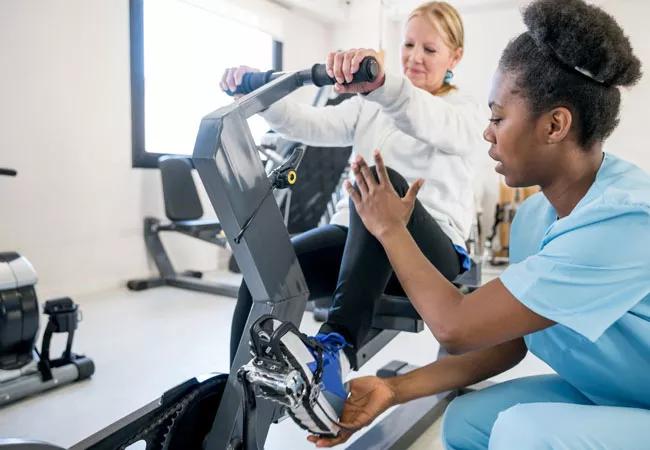Pilot study finds both forced- and voluntary-rate cycling effective for symptom management

A 12-week intervention of moderate- to high-intensity aerobic cycling significantly improved physical and overall fatigue, pain intensity and interference, and walking speed and capacity in people with multiple sclerosis (MS). The findings, from a Cleveland Clinic-led pilot study, suggest that aerobic exercise should be considered as part of a multifaceted approach to fatigue and pain in this population.
Advertisement
Cleveland Clinic is a non-profit academic medical center. Advertising on our site helps support our mission. We do not endorse non-Cleveland Clinic products or services. Policy
The results were described at the 2023 annual meeting of the Consortium of Multiple Sclerosis, reflecting positive experience with a novel form of forced-rate exercise (FE) and voluntary exercise (VE) in a small group of patients with MS.
“We previously reported on the benefits of forced-rate exercise in patients with Parkinson’s disease and stroke,” says lead researcher Susan Linder, DPT, PhD, Director of Clinical Research in Cleveland Clinic’s Department of Physical Medicine and Rehabilitation. “Our hypothesis for this feasibility study was that it also would be helpful for people with MS because impairments such as weakness and spasticity often limit their ability to exercise intensely or regularly.”
Twenty-two patients aged 18 to 75 years from Cleveland Clinic’s Mellen Center for Multiple Sclerosis were randomized to a protocol of either FE or VE. All patients had neurologist-confirmed MS with an Expanded Disability Status Scale (EDSS) score of 2.0 to 6.5 and were on stable spasticity/fatigue medications for at least two months.
Patients in the FE group used a semirecumbent stationary cycle ergometer custom-engineered with a motor to supplement their voluntary efforts to maintain a target pedaling rate of > 70 revolutions per minute. Patients in the VE group exercised on a comparable semirecumbent cycle ergometer at their self-selected pedaling cadence without assistance.
“The motor-assisted bike was developed at Cleveland Clinic and is designed to supplement, rather than replace, voluntary effort,” Dr. Linder explains. “It helps patients pedal at a faster cadence so they can achieve and sustain greater exercise intensity.”
Advertisement
Over the 12-week study period, both groups completed 24 cycling sessions. Held twice per week, sessions included a 5-minute warmup, a 35-minute main exercise set and a 5-minute cooldown. The target aerobic intensity for exercise set was 60% to 80% of age-predicted maximum heart rate, which was monitored and displayed continuously.
Clinical, biomechanical and self-reported outcomes were gathered before, immediately after and four weeks after the intervention to determine the effects of FE and VE on spatiotemporal and kinematic characteristics of gait, functional mobility, balance, fatigue, physical activity levels and quality of life.
The Modified Fatigue Impact Scale (MFIS) and Patient-Reported Outcomes Measurement Information System (PROMIS)-29 were used to measure changes in fatigue and pain, respectively. Biomechanical gait assessment and a 6-minute walk test (6MWT) were performed at baseline and week 13.
Of the 22 patients, 12 were randomized to FE and 10 to VE. Of these, 11 patients in the FE group and 7 in the VE group completed the study and were included in the analysis. Their mean (± SD) age was 54.9 ± 10.6 years.
Across the overall study population, statistically significant improvements were reported in the following:
Advertisement
No significant differences were found between the FE and VE groups in changes in MFIS scores or any PROMIS-29 scores, although the study was not powered to detect between-group differences.
“The 4.9-point absolute decrease in total MFIS after the cycling intervention was a pleasant surprise,” Dr. Linder notes. “It meets the threshold for a minimally clinically important difference in people with MS.”
Additionally, walking speed significantly increased across the overall population (from 0.61 to 0.68 m/s; P = 0.01), and a modest improvement was seen in the 6MWT (from 341.7 to 352.0 m).
The researchers found it noteworthy that patients across the spectrum of MS-associated disability were able to tolerate the exercise intervention. “One individual who presented with an EDSS of 6.5 was not able to complete VE but did complete the 12-week intervention using the FE cycle,” says Dr. Linder. “That suggests that forced-rate exercise may be a viable alternative to traditional exercise for those who have advanced disease or other physical limitations associated with MS.”
Evidence indicates that while moderate-intensity exercise generally is recommended for people with MS, up to 78% of this population reports no physical activity. Dr. Linder says the cause for this is likely fatigue, weakness and/or spasticity rather than disinterest in exercise. Overcoming those barriers could enable more people with MS to reap the proven benefits of exercise, which include increased energy reserves and altered pain sensitivity.
Advertisement
“Fatigue and pain are difficult to manage clinically in MS because of their multifactorial etiology,” Dr. Linder notes. “There are no negative effects of exercise, and it may improve other aspects of quality of life as well.”
The next step for the Cleveland Clinic team is performing longer-duration studies of high-intensity aerobic cycling as lifestyle modification for patients with MS. They believe studies employing mechanistic outcomes also are warranted to develop precise and individualized exercise prescriptions and elucidate the causal relationship between exercise and MS-related pain and fatigue.
Advertisement
Advertisement

Mixed results from phase 2 CALLIPER trial of novel dual-action compound

A co-author of the new recommendations shares the updates you need to know

Rebound risk is shaped by patient characteristics and mechanism of action of current DMT

First-of-kind prediction model demonstrates high consistency across internal and external validation

Real-world study also finds no significant rise in ocrelizumab-related risk with advanced age

Machine learning study associates discrete neuropsychological testing profiles with neurodegeneration

This MRI marker of inflammation can help differentiate MS from mimics early in the disease

Focuses include real-world research, expanding access and more